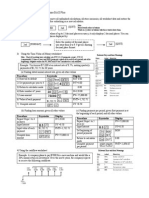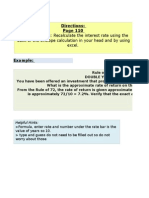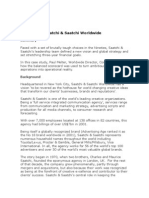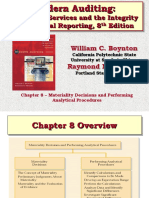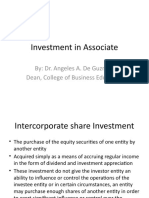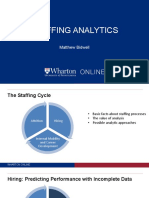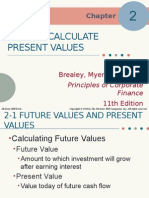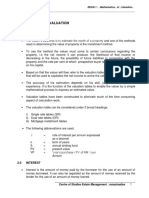0 ratings0% found this document useful (0 votes)
253 viewsRWJ Chapter 4
The document discusses discounted cash flow valuation and key concepts in time value of money calculations. It covers formulas and examples for calculating future value, present value, interest rates, time periods, compounding, discounting, annuities, and growing annuities. Examples are provided for common time value of money scenarios like investments, loans, and retirement planning. Financial calculators and tables are introduced as tools for solving time value of money problems.
Uploaded by
Parth ParthCopyright
© © All Rights Reserved
We take content rights seriously. If you suspect this is your content, claim it here.
Available Formats
Download as PPT, PDF, TXT or read online on Scribd
0 ratings0% found this document useful (0 votes)
253 viewsRWJ Chapter 4
The document discusses discounted cash flow valuation and key concepts in time value of money calculations. It covers formulas and examples for calculating future value, present value, interest rates, time periods, compounding, discounting, annuities, and growing annuities. Examples are provided for common time value of money scenarios like investments, loans, and retirement planning. Financial calculators and tables are introduced as tools for solving time value of money problems.
Uploaded by
Parth ParthCopyright
© © All Rights Reserved
We take content rights seriously. If you suspect this is your content, claim it here.
Available Formats
Download as PPT, PDF, TXT or read online on Scribd
You are on page 1/ 52
Chapter 4: Discounted cash flow
valuation
Corporate Finance
Ross, Westerfield, and
Jaffe
Outline
4.1 Future value
4.2 Present value
4.3 Other parameters
4.4 Multiple cash flows
4.5 Comparing rates
4.6 Loan types
Definitions
Present value (PV): earlier money on a time line.
Future value (FV): later money on a time line.
Interest rate (i), e.g., discount rate, required rate,
cost of capital: exchange rate between earlier money
and later money.
The number of time periods on a time line (N).
PV FV: “time value of money” via the exchange
rate, i.e., interest rate, i.
End-of-period cash flows
By default, in this class cash flows occur
at the end of each period.
If cash flows occur at the beginning of each
period, it will be explicitly specified.
One equation; one solution
In general, we have one equation: 0 = f (PV,
FV, i, N).
Since we have only one equation, we can
only allow for one unknown parameter
(variable). That is, if we’d like to calculate
the value of a parameter, say FV, the values
of the remaining parameters, i.e., PV, i, and
N, need to be known.
FV example I
Suppose that we buy a 12-month CD at 12%
annual interest rate for $10,000.
FV = PV (1 + i)N = $10,000 (1 + 12%)1 =
$11,200.
Do not compare apples with oranges
Why N = 1 while the CD matures in 12 months? The
key is that:
The time frequency of i and N must be the same.
If we use annual interest rate, then we need to
measure the investment period using the unit of
year. In this case, 12 months equal a year; so N = 1.
What is the value of N if the example provided us
monthly interest rate, say 0.96% per month?
Any volunteer?
Compounding
Of course, the previous formula, FV = PV
(1 + i)N, is based on the notion of
compounding.
Compounding: the process of accumulating
interest on an investment over time to earn
more interest.
– Earn interest on interest.
– Reinvest the interest.
– A popular method.
FV example II
Deposit $50,000 in a bank account paying 5%. How
much will you have in 6 years?
Formula: FV = PV (1 + i)N = $50,000 (1 + 5%)6 =
$67,000.
Financial table (Table A.3): FV = $50,000 1.3401 =
$67,000.
Financial calculator: 6 N; 5 I/Y; 50000 PV; CPT FV.
The answer is FV = -67,004.7820. Ignore the
negative sign.
Texas Instruments BAII Plus (keys)
• FV: future value.
• PV: present value.
• I/Y: period interest rate.
- Interest is entered as a percent.
• N = number of time periods.
• Clear the registers (CLR TVM, i.e., 2nd FV) after
each calculation; otherwise, your next calculation
may come up with a wrong answer.
FV example, III
Jacob invested $1,000 in the stock of IBM. IBM pays
a current dividend of $2 per share, which is expected
to grow by 20% per year for the next 2 years. What
will the dividend of IBM be after 2 years?
Formula: FV = PV (1 + i)N = $2 (1 + 20%)2 =
$2.88.
Table A.3: FV = $2 1.4400 = $2.88.
Calculator: 2 PV; 20 I/Y; 2 N; CPT FV. The answer
is -2.8800.
Discounting
Discounting: the process of calculating the
present value of future cash flows.
We call i the discount rate when we try to
solve for present value. Depending on the
question, this rate can be interest rate, cost
of capital, or opportunity cost.
PV example, I
Suppose that you need $4,000 to pay your
tuition. 1-year CD interest rate is 7%. How
much do you need to put up today?
Formula: PV = FV / (1 + i)N = $4,000 / (1 +
7%)1 = $3,738.3.
Table A.1: PV = $4,000 0.9346 = $3,738.4.
Calculator: 4000 FV; 7 I/Y; 1 N; CPT PV.
The answer is -3,738.3178.
PV example, II
Suppose that you are 21 years old. Your annual discount
(return) rate is 10%. How much do you need to invest today in
order to reach $1 million by the time you reach 65?
Formula: PV = FV / (1 + i)N = $1,000,000 / (1 + 10%)44 =
$15,091.
Table A.1 does not have the present value factor for N = 44.
This is the limitation of using a financial table. Thus, we will
focus on the other 2 methods in the following discussions.
Calculator: 1000000 FV; 10 I/Y; 44 N; CPT PV. The answer is -
15,091.1332.
PV relationship, I
Holding interest rate constant – the longer
the time period, the lower the PV.
– What is the present value of $5,000 to be
received in 5 years? 10 years? The discount rate
is 8%
– 5 years: 5 N; 8 I/Y; 5000 FV; CPT PV. The
answer is PV = -3,402.9160.
– 10 years: 10 N; 8 I/Y; 5000 FV; CPT PV. The
answer is PV = -2,315.9674.
PV relationship, II
Holding time period constant – the higher the
interest rate, the smaller the PV.
– What is the present value of $5,000 received in 5
years if the interest rate is 10%? 15%?
– 10%: 10 I/Y; 5 N; 5000 FV; CPT PV. The answer
is PV = -3,104.6066.
– 15%: 15 I/Y; 5 N; 5000 FV; CPT PV. The answer
is PV = -2,485.8837.
The other parameters
Recall that 0 = f (PV, FV, i, N).
We can find the value of i or N as long as we know
about the values of the other parameters.
The easiest way is to use a financial calculator.
They are formulas, i.e., analytical solutions, for i and
N as well. But these are not the focus of the course.
Interest rate example
Suppose that you deposit $5,000 today in a
bank account paying interest rate i per year.
If you reach $10,000 in 10 years, what rate of
return are you being offered?
Calculator: 5000 PV; -10000 FV; 10 N; CPT
I/Y. The answer is I/Y = 7.1773.
Note that for entering -10000 FV, this is the
sequence: 10000 +/– FV.
Time period example
Suppose that you have $10,000 today. You
want to retire as a millionaire. The annual
rate of return that you can earn on the
market is 10%. In how many years can you
retire?
Calculator: 10000 PV; -1000000 FV; 10 I/Y;
CPT N. The answer is: N = 48.3177.
Multiple cash flows
When there are multiple cash flows need to
be discounted or compounded, the PV or FV
of multiple cash flows are simply the sum of
individual PV’s or FV’s, respectively.
Multiple cash flow example
Dennis has won the Kentucky State Lottery and will
receive $2,000 (cash flow 1)in a year and $5,000
(cash flow 2) in 2 years. Dennis can earn 6% in his
money market account, so the appropriate discount
rate is 6%.
PV = PV1 + PV2 = $2,000 / (1 + 6%)1 + $5,000 / (1 +
6%)2 = $6,337.
That is, Dennis is equally inclined toward receiving
$6,337 today and receiving $2,000 and $5,000 over
the next 2 years.
Multiple cash flow example, Excel
Year CF Discount rate PV
0
1 2000 0.06 1886.792
2 5000 0.06 4449.982
6336.775
Annuity
(Ordinary) Annuity: a level of stream of cash
flows for a fixed period of time (multiple,
equal cash flows).
– Same dollar amount per period, making
calculation much easier.
FV = C { [ (1 + i)N – 1] / i }.
PV = C { [ 1 – 1 / (1 + i)N ] / i }.
– C is the fixed periodical payment.
Annuity PV example
Suppose that you want to buy a car. You can afford
to pay $632 per month for the next 48 months. You
borrow at 1% per month for 48 months. How much
can you borrow?
Formula: PV = C { [ 1 – 1 / (1 + i)N ] / i } = $632 { [
1 – 1 / (1 + 1%)48 ] / 1% } = $24,000.
Calculator: 632 PMT; 1 I/Y; 48 N; CPT PV. The
answer is: PV = -23,999.5424.
In the solution manual (textbook), PVIFA (PVIA)
stands for the PV of an annuity.
PVIFA(i,N) = [ 1 – 1 / (1 + i)N ] / i .
Let’s work on this
Questions and Problems #28
More generally
PVt = Ct+1 { [ 1 – 1 / (1 + i)N ] / i }.
where, the first cash flow occurs at t+1.
Annuity FV example
Suppose that you put $3,000 per year into a
Roth IRA. The account pays 6% per year.
How much will you have when you retire in
30 years?
Formula: FV = C { [ (1 + i)N – 1] / i } =
$3,000 { [ (1 + 6%)30 – 1] / 6% } =
$237,174.56.
Calculator: 3000 PMT; 6 I/Y; 30 N; CPT FV.
The answer is: FV = -237,174.5586.
Other parameters for annuity
An insurance company offers to pay you
$10,000 per year for 10 years if you will pay
$67,100 up front. What is the rate of return?
Calculator: -67100 PV; 10000 PMT; 10 N;
CPT I/Y. The answer is: I/Y = 8.0003.
Annuity due
Annuity due: an annuity for which the cash
flows occur at the beginning of the period.
For calculating PV and FV of an annuity due,
we can use the following formula: Annuity
due value = ordinary annuity value (1 + i).
Annuity due example
You are going to rent an apartment for a year. You
have 2 choices: (1) pay the monthly rent, $500, at
the beginning of the month, or (2) pay the entire
year’s rent, $5,000, today. Suppose that you can
earn 1% every month. Which is the better choice?
Ordinary PV: 500 PMT; 1 I/Y; 12 N; CPT PV. The
answer is: PV = -5,627.5387.
Annuity due PV = ordinary PV (1 + i) =
$5,627.5387 1.01 = $5,683.8141.
You would want to pay $5,000 today if you can.
Growing annuity
Growing annuity: a finite number of growing
cash flows, where the constant growth rate is
g.
PV = C { [ 1 – ((1 + g) / (1 + i))N ] / (i – g) }.
More generally, PVt = Ct+1 { [ 1 – ((1 + g) /
(1 + i))N ] / (i – g) }
Growing annuity example
Emily has just been offered a job at $80,000
a year. She anticipates her salary increasing
by 9% a year until her retirement in 40 years.
Given an interest rate of 20%, what is the
present value of her lifetime salary?
PV = C { [ 1 – ((1 + g) / (1 + i))N ] / (i – g) } =
$80,000 { [ 1 – ((1 + 9%) / (1 + 20%))40 ] /
(20% – 9%) } = $711,730.71.
Perpetuity
Perpetuity: a constant stream of cash flows
without end.
PV = C / i.
Perpetuity example
Preferred stock promises the buyer a fixed
cash dividend every period (usually every
quarter) forever. Suppose that VTinsurance
Inc. wants to sell preferred stock. The
quarterly dividend is $1 per share. The
required rate of return for this issue is 2.5%
per quarter. What is the fair value of this
issue?
PV = C / i = $1 / 2.5% = $40 (per share).
Growing perpetuity
Growing perpetuity: an infinite cash flow
stream that grows at a constant rate, g.
PV = C1 / (i – g), C1 is the cash flow at time 1.
More generally, PVt = Ct+1 / (i – g)
Note that i needs to be greater than g.
Growing perpetuity example
Toyota is expected to pay a dividend (annual
dividend) of $3 per share in a year. Investors
also anticipate that the annual dividend will
rise by 6% per year forever. The applicable
discount rate is 11%. What is the present
value of future dividends?
PV = C1 / (i – g) = $3 / (11% – 6%) = $60 per
share.
Comparing rates, I
Rates are quoted in many different ways.
– Tradition.
– Legislation.
Effective annual rate (EAR): the actual rate paid (or
received) after accounting for compounding that
occurs during the year.
When comparing two alternative investments with
different compounding frequencies, one needs to
compute the EARs and use them for reaching a
decision.
Comparing rates, II
Annual percentage rate (APR) or stated
annual interest rate (SAIR): the annual rate
without consideration of compounding.
APR = period rate the number of periods
per year, m.
EAR = [1 + (APR / m)]m – 1.
Rate example, I
You went to a bank to borrow $10,000. You
were told that the rate is quoted as “8%
compounded semiannually.” What is the
amount of debt after a year?
FV = PV (1 + i)N = $10,000 (1 + 4%)2 =
$10,816.
EAR = [1 + (APR / m)]m – 1= [1 + (8% / 2)]2 –
1 = 8.16%.
Rate example, II
What is the APR if the monthly rate is 1%?
APR = 1% 12 = 12%.
What is the monthly (period) rate if the APR
is 6% with monthly compounding?
Period (monthly) rate = 6% / 12 = 0.5%.
Continuously compounding
FV = PV × eAPR×the number of years , where e has
the value of 2.718.
Suppose that you invest $1,000 at a
continuously compounded rate of 10% for a
year.
FV = PV × eAPR×the number of years = $1,000 ×
e10%×1 = $1,105.20. So, EAR = 10.52%.
APR vs. EAR in real life
By Trust-in-saving law, banks need to disclose EAR
( or called annual percentage yield (APY), or
effective annual yield (EAY)). So you get the correct
rate when you save.
By Trust-in-lending law, banks need to disclose
APR, the stated (quoted) rate. So you get a
seemingly low rate when you borrow.
Extra
In residential mortgage markets, “APR” is
the cost of credit that includes the quoted
rate and transactions costs.
This APR is higher than the quoted rate.
If it is 0.75%-1% higher than the quoted rate,
the financial charges and fees are most likely
too high.
Example: a quote from quickloans.com: rate
3.625% (3.8% APR)
Pure discount loans
Pure discount loans: the borrower receives money
today and repays a single lump sum at some time in
the future.
Treasury bills: U.S. government borrows money and
promises to repay a fixed amount at some time less
than one year. Suppose that the maturity is 12
months. The face value is $10,000. The market
discount rate is 7%. How much do you need to pay
for the T-bill?
PV = FV / (1 + i)N = $10,000 / (1 + 7%)1 = $9,345.79.
Amortized loans
Amortized loans: the loans that are paid off
by making regular principal reductions.
– Payment per period = interest + a portion of
principal.
– The most common type of amortized loans
require borrowers make a single, fixed payment
every period, i.e., annuity.
Buying a house, I
You are ready to buy a house and you have $20,000
for a down payment and closing costs. Closing
costs are estimated to be $5,500. The interest rate
on the loan is 6% per year with monthly
compounding (.5% per month) for a 30-year fixed
rate loan. You are able to buy the house at
$154,500. What is the monthly payment? Suppose
that you have an annual salary of $50,000. What is
the ratio of the mortgage payment to your monthly
income?
Buying a house, II
Down payment = $20,000 – $5,500 = $14,500.
Loan = $154,500 – $14,500 = $140,000.
Calculator: 140000 PV; 0.5 I/Y; 360 N; CPT PMT.
The answer is: PMT = -839.3707.
PMT/income = $839.3707 / ($50,000 / 12) = 20.14%.
Banks usually do not want to see this ratio to be
higher than 25%.
Interest-only loans
Interest-only loans: borrower pays interest
each period and repay the entire original
principal at some time in the future.
– Example: bonds.
This serves as a launch point for next topic:
Chapters 8 & 9: How to value bonds and
stocks.
Review: let us work on this one
Q11, P. 125: Conoly Co. Has identified an
investment project with the following cash
flows. If the discount rate is 10%, what is the
PV?
Year 1: $960. Year 2: $840. Year 3: $935.
Year 4: $1,350.
Review: let us work on this one
Concept #3, p. 123. Suppose that two
athletes sign 10-year contracts for $80
million. In one case, we are told that the $80
million will be paid in 10 equal installments.
In the other case, we are told that the $80
million will be paid in 10 installments, but the
installments will increase by 5% per year.
Who got the better deal? Why?
Assignment
Please analyze the following statement: “on
average, pursuing a 4-year college degree is
a value-added proposition.”
Must utilize TVM concept.
Understanding Questions and Problems #28
(p.127) will be beneficial.
A typed report; due in a week.
Individual assignment.
End-of-chapter
Concept questions: 1-10.
Questions and problems: 1-28, 30-41, 43,
and 45-50 (also excluding those questions
with variable/differential discount rates).
You might also like
- 5.chapter 5 - Multinational Capital BudgetingNo ratings yet5.chapter 5 - Multinational Capital Budgeting26 pages
- Fundamentals of Management Control: Zarlowski P., Saulpic O., Giraud F., Dambrin CNo ratings yetFundamentals of Management Control: Zarlowski P., Saulpic O., Giraud F., Dambrin C179 pages
- Time Value of Money: Future Value Present Value Annuities Rates of Return AmortizationNo ratings yetTime Value of Money: Future Value Present Value Annuities Rates of Return Amortization52 pages
- Time Value of Money: - Future Value - Present Value - Annuities - Rate of Return - AmortizationNo ratings yetTime Value of Money: - Future Value - Present Value - Annuities - Rate of Return - Amortization132 pages
- Fund - Finance - Lecture 2 - Time Value of Money - 2011No ratings yetFund - Finance - Lecture 2 - Time Value of Money - 2011101 pages
- Quick Guide To Using Your Texas BAII PlusNo ratings yetQuick Guide To Using Your Texas BAII Plus2 pages
- Introduction To Corporate Finance: Answers To Concept Questions 1No ratings yetIntroduction To Corporate Finance: Answers To Concept Questions 12 pages
- CH 1 - Multinational Financial Management OverviewNo ratings yetCH 1 - Multinational Financial Management Overview4 pages
- Accounting Information Systems Controls Processes 3rd Edition Turner Solutions Manual - Download PDF100% (3)Accounting Information Systems Controls Processes 3rd Edition Turner Solutions Manual - Download PDF51 pages
- Capital Budgeting Techniques: ID: MA0N0219No ratings yetCapital Budgeting Techniques: ID: MA0N021914 pages
- Southeastern Steel Company Dividend Policy Financial ManagementNo ratings yetSoutheastern Steel Company Dividend Policy Financial Management24 pages
- Accounting..... All Questions & Answer.No ratings yetAccounting..... All Questions & Answer.13 pages
- UvA IFRS 1 Consolidation and Business Combinations BBNo ratings yetUvA IFRS 1 Consolidation and Business Combinations BB80 pages
- Comparative International Auditing and Corporate Governance: ThirteenNo ratings yetComparative International Auditing and Corporate Governance: Thirteen47 pages
- Developing Financial Insights - Using A Future Value (FV) and A Present Value (PV) Approach PDF50% (2)Developing Financial Insights - Using A Future Value (FV) and A Present Value (PV) Approach PDF12 pages
- International Arbitrage and Interest Rate Parity Chapter 7 Flashcards - QuizletNo ratings yetInternational Arbitrage and Interest Rate Parity Chapter 7 Flashcards - Quizlet11 pages
- Download full (PowerPoint) Investments 10th Edition by Bodie ebook all chapters100% (2)Download full (PowerPoint) Investments 10th Edition by Bodie ebook all chapters18 pages
- Five Forces Model For External AnalysisNo ratings yetFive Forces Model For External Analysis20 pages
- Chapter No:-1 1.1: Introduction of Audit: Stakeholders Material Legal PersonNo ratings yetChapter No:-1 1.1: Introduction of Audit: Stakeholders Material Legal Person31 pages
- BFW2140 Lecture Week 2: Corporate Financial Mathematics INo ratings yetBFW2140 Lecture Week 2: Corporate Financial Mathematics I33 pages
- Lecture 3 - Discounted Cash Flow Valuation - Chapter 6No ratings yetLecture 3 - Discounted Cash Flow Valuation - Chapter 660 pages
- FM - Lecture 2 - Time Value of Money PDFNo ratings yetFM - Lecture 2 - Time Value of Money PDF82 pages
- 商四 A 管理會計 九十五學年度第二學期 QUIZ 2 原屬班級: - - - - - - - - - - - 學號: - - - - - - - - - - - 姓名: - - - - - - - - - - - - - - -No ratings yet商四 A 管理會計 九十五學年度第二學期 QUIZ 2 原屬班級: - - - - - - - - - - - 學號: - - - - - - - - - - - 姓名: - - - - - - - - - - - - - - -4 pages
- Personality Traits - Juror No. 6 12 Angry Men: Prepared byNo ratings yetPersonality Traits - Juror No. 6 12 Angry Men: Prepared by7 pages
- Financial Management Principles and Applications 12th Edition Titman Solutions Manualdownload100% (8)Financial Management Principles and Applications 12th Edition Titman Solutions Manualdownload30 pages
- 33 Comm 308 Final Exam (Summer 1 2018) SolutionsNo ratings yet33 Comm 308 Final Exam (Summer 1 2018) Solutions13 pages
- Week 3 - Introduction To Time Value of MoneyNo ratings yetWeek 3 - Introduction To Time Value of Money5 pages
- Future Value of 1 Sample Problem: SolutionNo ratings yetFuture Value of 1 Sample Problem: Solution9 pages
- Financial Management Principles and Applications 12th Edition Titman Solutions Manual pdf download100% (1)Financial Management Principles and Applications 12th Edition Titman Solutions Manual pdf download37 pages
- Valuation of Shares and Bonds: Concepts OverviewNo ratings yetValuation of Shares and Bonds: Concepts Overview22 pages
- Chap003 - Time Value of Money and DCF ModelNo ratings yetChap003 - Time Value of Money and DCF Model55 pages

























